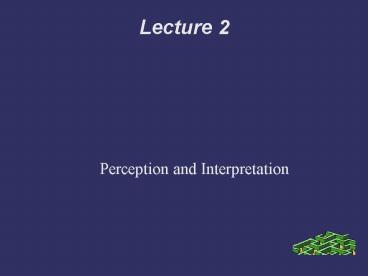Perception and Interpretation - PowerPoint PPT Presentation
1 / 19
Title:
Perception and Interpretation
Description:
Symbolism and interpretation. Semiotic analysis. Perceptual positioning ... The role of symbolism in interpretation. Every message has three basic components: ... – PowerPoint PPT presentation
Number of Views:598
Avg rating:3.0/5.0
Title: Perception and Interpretation
1
Lecture 2
- Perception and Interpretation
2
Topics
- Perception and the Perceptual Process
- Sensory systems
- Exposure thresholds
- Perceptual selection
- Symbolism and interpretation
- Semiotic analysis
- Perceptual positioning
3
Perception defined
Perception is the process by which physical
sensations such as sights, sounds, and smells are
selected, organised and interpreted. The eventual
interpretation of the stimulus allows it to be
assigned meaning.
4
The Perception Process
- Three basic stages in the perceptual process
- Exposure (receive sensations)?
- Attention(do we notice)?
- Interpretation (how do we understand it)?
5
The perceptual process
Figure 2.1
6
The stages of a perceptual process
- Primitive categorization in which the basic
characteristics of a stimulus are isolated. - Cue check the characteristics are analysed in
preparation for the selection of a schema. - Confirmation check in which the schema is
selected. - Confirmation completion in which a decision is
made as to what the stimulus is.
7
Impact of the different stimuli
- Vision marketers rely heavily on visual
elements in advertising, store design and
packaging. Colours are rich in symbolic value and
cultural meanings and can be critical spurs to
sales. - Smell odours can stir the emotions or have a
calming effect, they can invoke memories or
relieve stress. - Sound can affect peoples feelings and
behaviours. - Touch tactile cues can have symbolic meaning.
- Taste can contribute to our experiences of many
products.
8
Sensory Systems
- Sensory inputs received on a number of channels
- Five Senses
- External stimuli can trigger memories from past
part of hedonic consumption an emotional
relationship with the product - Unique sensory quality makes a product stand out
9
The different sensory thresholds
- Absolute threshold - the minimum amount of
stimulation that can be detected on a sensory
channel. - Differential threshold - the ability of a sensory
system to detect changes or differences between
two stimuli. The issue of when or if a change
will be noticed is relevant to many marketing
situations. - The minimum change in a stimulus that can be
detected is known as the JND Just Noticeable
Difference. - Webers Law states that the amount of change that
is necessary to be noticed is related to the
original intensity of the stimulus.
10
Perceptual selection
Consumers are often in a state of sensory
overload, exposed to too much information and are
unable or unwilling to process all of the
information at their disposal. Perceptual
selectivity occurs when people attend to only a
small portion of the stimuli that they are
exposed to.
11
Perceptual principles for organising stimuli
- Gestalt psychology people derive meaning from
the totality of a set of stimuli rather than from
any one individual stimuli. - Principle of closure consumers tend to perceive
an incomplete picture as complete, filling in the
blanks based on previous experience. - Principle of similarity consumers tend to group
together objects that share similar physical
characteristics. - Figure ground principle where one part of the
stimulus will dominate while others recede into
the background.
12
Interpreting meaning
Interpretation refers to the meaning that people
assign to phenomena, whether from stimuli from
the outside world or the ideas and concepts from
the persons own mind.
- Priming where consumers assign meaning based on
the set of beliefs held. - Symbolic consumption where the meanings
attached to the act of consuming the goods, for
example trendiness, wealth, femininity, etc. - Stimulus Ambiguity where consumers project
their own experiences and aspirations to assign
meaning. - Stimulus organisation where people relate
incoming sensations to imagery of other
sensations already in memory based on fundamental
organisation principles.
13
The role of symbolism in interpretation
- Some marketers are turning to semiotics to
understand how consumers interpret the meanings
of symbols. - Semiotics examines the correspondence between
signs and symbols and their role in the
assignment of meaning. - Products are given meanings by their producers
and we rely on advertising to work out what those
meanings are. Advertising serves as a kind of
culture/consumption dictionary. - Hyperreality refers to the becoming real of
what is initially hype
14
Semiotic principles
- Every message has three basic components
- Lowest level the object or the product that is
the focus of the message. - Middle level the sign or the sensory image that
represents the unintended meanings of the object. - Top level the interpretant or the derived
meaning.
15
Relationship of Sign to Object
- Icon resembles the product
- (guiness man)?
- Index shares characteristics with product
(the waterfall and the shampoo)? - Symbol A meaning is related to a product by
general agreement - (the Mercedes star)?
16
Positioning strategy
A positional strategy is a fundamental part of a
companys marketing efforts as it uses the
different elements of the marketing mix (product,
price, place, promotions, etc) to influence
consumers interpretation of its meaning.
17
Brand positioning dimensions
- Lifestyle.
- Price leadership.
- Attributes.
- Product class.
- Competitors.
- Occasions.
- Users.
- Quality.
18
Perceptual map
- A perceptual map is a useful positioning tool
that identifies the important dimensions and then
asks consumers to place competitors in this
space. - Marketers can then analyse similarities and
differences between products and the
opportunities for new products possessing
attributes not represented by current brands.
19
Reading
- Ch 2 of Consumer Behaviour A European Perspective
by Solomon, Bamossy et al - Article Exploring the morphology of signs,
symbols and significance by Mick 1986 - CMG Color forecasting Autumn 2008






























![READ⚡[PDF]✔ Reconsidering Interpretation of Heritage Sites: America in the Eighteenth PowerPoint PPT Presentation](https://s3.amazonaws.com/images.powershow.com/10050439.th0.jpg?_=20240607121)